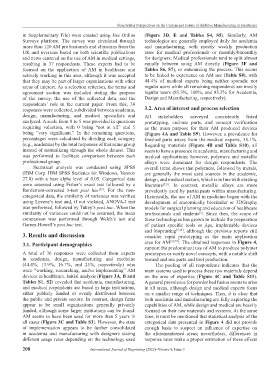Page 216 - IJB-8-3
P. 216
Stakeholder Perspectives on the Current and Future of Additive Manufacturing in Healthcare
in Supplementary File) were created using Jisc Online (Figure 3D, E and Tables S4, S5). Similarly, AM
Surveys platform. The survey was circulated through technologies are generally employed daily for academia
more than 120 AM professionals and clinicians from the and manufacturing, with mostly weekly production
UK and overseas based on both scientific publications rates for medical professionals or monthly/bimonthly
and news centered on the use of AM in medical settings, for designers. Medical professionals tend to split almost
resulting in 37 respondents. These experts had to be equally between using AM directly (Figure 3F and
focused on the application of AM in healthcare and Tables S6, S7), or outsourcing the process. This seems
actively working in this area, although it was accepted to be linked to experience on AM use (Table S8), with
that they may be part of larger organizations with other 44.4% of medical experts being neither sporadic nor
areas of interest. As a selection criterion, the terms and regular users while all remaining respondents are mostly
agreement section was included stating the purpose regular users (81.3%, 100%, and 83.3% for Academia,
of the survey, the use of the collected data, and the Design and Manufacturing, respectively).
respondents’ role in the current paper. From this, 36
responses were collected, subdivided between academia, 3.2. Area of interest and process selection
design, manufacturing, and medical specialists and All stakeholders surveyed consistently listed
analyzed. A scale from 0 to 5 was provided in questions prototyping, end-use parts, and concept verification
requiring valuation, with 0 being “not at all” and 5 as the main purpose for their AM produced devices
being “very significant.” In the remaining questions, (Figure 4A and Table S9). However, a prevalence for
percentages were calculated by dividing each category finished parts arises from the medical experts, 38.1%.
(e.g., academia) by the total responses of that same group Regarding materials (Figure 4B and Table S10), all
instead of normalizing through the whole dataset. This seem to have a presence in academia, manufacturing and
was performed to facilitate comparison between each medical applications; however, polymers and metallic
professional group. alloys were dominant for design respondents. The
Statistical analysis was conducted using SPSS overall trend shows that polymers, followed by metals,
(IBM Corp. IBM SPSS Statistics for Windows, Version are generally the most used sources in the academic,
27.0) with a base alpha level of 0.05. Categorical data design, and medical sectors, which is in line with existing
were assessed using Fisher’s exact test followed by a literature [7,9] . In contrast, metallic alloys are more
Bonferroni-corrected z-test post hoc . For the non- prevalently used by participants within manufacturing.
[33]
categorical data, the similarity of variances was verified Historically, the use of AM in medicine began with the
using Levene’s test and, if not violated, ANOVA-I test development of anatomically biosimilar or 3DGraphy
was performed, followed by Tukey’s post hoc. When the models for surgical planning and education of healthcare
similarity of variances could not be assumed, the mean professionals and students . Since then, the scope of
[5]
comparison was performed through Welch’s test and these technologies has grown to include the preparation
Games-Howell’s post hoc test. of patient specific tools or jigs, implantable devices
and bioprinting [5,34] , although the previous reports still
3. Results and discussion consider rapid prototyping as the main application
3.1. Participant demographics area for AM [35-37] . The obtained responses in Figure 4,
support the predominant use of AM to produce polymer
A total of 36 responses were collected from experts prototypes or verify novel concepts, with a notable shift
in academia, design, manufacturing and medicine toward end use parts and tool production.
(44.4%, 13.9%, 16.7%, and 25%, respectively) who The pooling of all respondents indicates that the
were “working, researching, and/or implementing” AM main systems used to process these raw materials depend
devices in healthcare. Initial analysis (Figure 3A, B and on the area of expertise (Figure 4C and Table S11).
Tables S1, S2) revealed that academia, manufacturing, A general prevalence for powder bed fusion seems to arise
and medical respondents are based in large institutions, in all areas, although design and medical experts focus
either publicly funded or evenly distributed between on a smaller range of techniques. Thus, it is clear that
the public and private sectors. In contrast, design firms both academia and manufacturing are fully exploring the
appear to be small organizations generally privately capabilities of AM, while design and medical are heavily
funded, although some larger institutions can be found. focused on their raw materials and systems. At the same
AM seems to have been used for more than 5 years in time, it must be mentioned that statistical analysis of the
all cases (Figure 3C and Table S3). However, the state categorical data presented in Figure 4 did not provide
of implementation appears to be further consolidated enough basis to suspect an influence of expertise on
in academia and manufacturing with designers stating the aforementioned areas; nevertheless, differences in
different usage rates depending on the technology used response rates make a proper estimation of these effects
208 International Journal of Bioprinting (2022)–Volume 8, Issue 3

